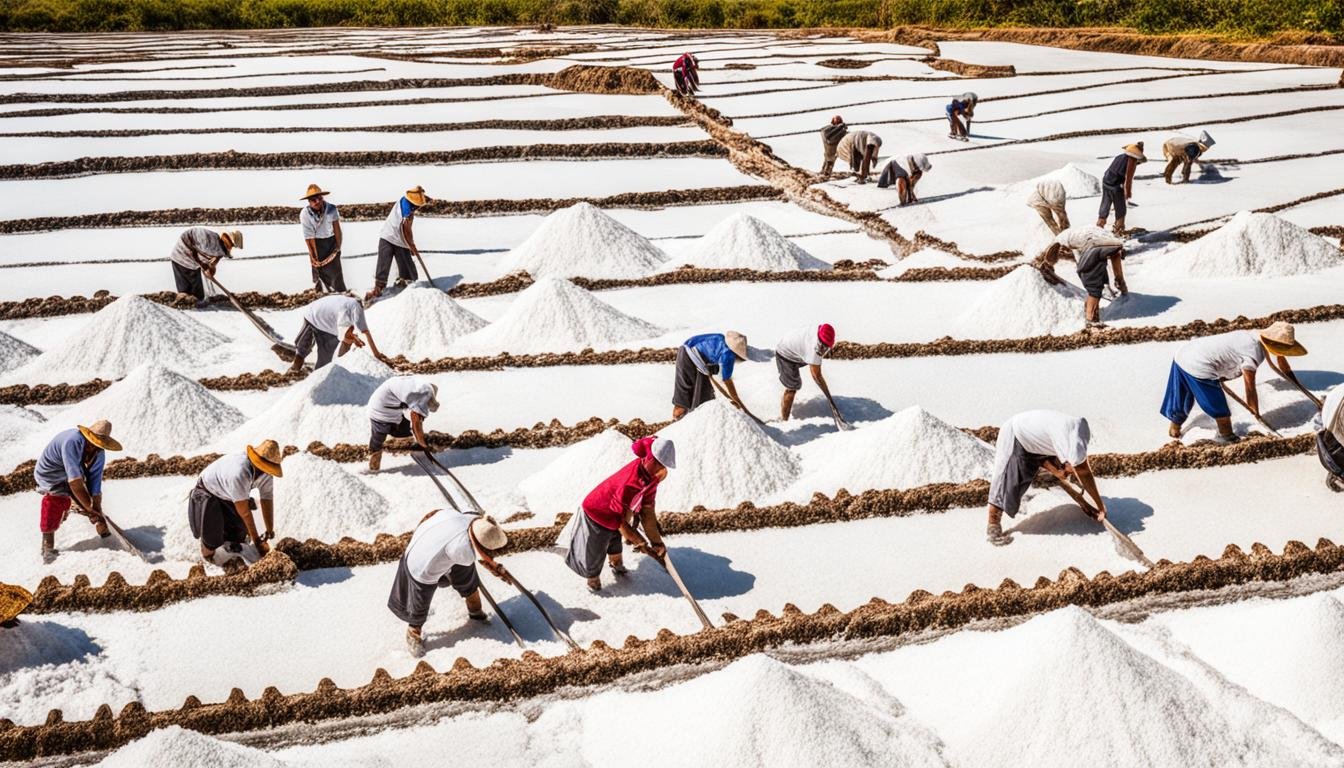Have you ever wondered about the stories hidden behind the names of places? How the names themselves can offer a glimpse into the rich history and culture of a region? In this article, we delve into the intriguing origins of the names “Pangasinan” and “Lingayen” in the context of the Philippines. Prepare to be captivated as we explore the etymology, linguistic legacy, and cultural significance of these names, shedding light on the vibrant heritage of Pangasinan.
Key Takeaways:
- Discover the fascinating meaning and origins of the names “Pangasinan” and “Lingayen”
- Gain valuable insights into the history and culture of Pangasinan through these place names
- Explore the linguistic legacy of Pangasinan and its connection to other indigenous languages
- Uncover the significance of salt production in Pangasinan and its impact on the region
- Get a glimpse into the vibrant culture and travel opportunities that Pangasinan has to offer
Pangasinan – The Land of Salt
The name “Pangasinan” holds a deep historical significance in the Philippines, particularly in relation to its thriving salt industry. Derived from the Pangasinan phrase “pang-asim,” which means “place of salt,” the name reflects the region’s rich history of salt production.

Pangasinan province is renowned for its abundant salt beds and its traditional method of evaporating seawater to produce salt. For centuries, the Pangasinan people have mastered the art of salt production, making it an integral part of their culture and economy.
Located along the western coast of Luzon, Pangasinan’s favorable geographical location allows for easy access to seawater, which is then transformed into the precious mineral. The province’s salt beds have played a vital role in sustaining local livelihoods and contributing to the region’s economic growth.
The historical importance of salt in Pangasinan goes beyond its economic value. The production of salt has shaped the region’s identity and cultural practices, influencing traditional cuisines and preserving age-old traditions. The extraction of salt from seawater continues to be seen as a symbol of the resilience and resourcefulness of the Pangasinan people.
With its reputation as the “Land of Salt,” Pangasinan offers visitors a unique opportunity to immerse themselves in the fascinating world of salt production. Travelers can explore the salt farms, witness the traditional method of evaporating seawater, and even participate in the process, gaining firsthand knowledge of the age-old craft.
As we delve into the etymology and significance of the name “Pangasinan,” we gain a deeper understanding of the historical and cultural legacy that revolves around this remarkable province. The name serves as a testament to the enduring tradition of salt production and the deep-rooted connection between the Pangasinan people and their remarkable land.
Lingayen – To Look Back
The name “Lingayen” has its roots in the Pangasinan word “lingawen,” which means “to look back.”
During the course of history, Lingayen has played a significant role as a strategic point, particularly during World War II. Its location along the Lingayen Gulf made it a key area of interest for military operations. Today, Lingayen is a bustling city that stands as the capital of the province of Pangasinan.
The Lingayen Gulf, closely associated with the city, holds both historical and ecological importance. It serves as a vital fishing ground and a significant commercial port. Over the years, the Lingayen Gulf has witnessed numerous events that shaped the region’s history and culture.
Exploring the etymology of “Lingayen” provides valuable insights into the historical and cultural legacy of this region. The name’s translation encourages us to look back and delve into the rich heritage of Lingayen and the province of Pangasinan. Understanding the significance of the name allows for a deeper appreciation of the history and traditions that continue to thrive in this vibrant city.
Linguistic Legacy and History
The Pangasinan language holds a significant place in the linguistic landscape of the Philippines. As one of the indigenous languages of the Philippines, it belongs to the Austronesian language family, which encompasses a diverse group of languages spoken across Southeast Asia and the Pacific. The roots of the Pangasinan language can be traced back to the pre-colonial era, reflecting the rich linguistic heritage of the region.
Throughout history, the Pangasinan language has been influenced by various external factors, most notably the Spanish colonization of the Philippines. The arrival of the Spanish in the 16th century brought about significant changes to the linguistic landscape of the country, including the introduction of Spanish loanwords and the adoption of the Roman alphabet for writing Pangasinan.
Despite the impact of colonization, the Pangasinan language has managed to preserve its distinct identity and continues to be spoken by a significant number of people in the Pangasinan province. Efforts have been made to promote and revitalize the language, including the inclusion of Pangasinan in educational programs and the development of language preservation initiatives.
Understanding the linguistic history of Pangasinan sheds light on the cultural heritage and identity of the region. It serves as a reminder of the diverse linguistic tapestry of the Philippines and the importance of preserving indigenous languages as a means of honoring and celebrating the rich cultural diversity of the country.
Beyond the Names: Culture and Travel
The place names “Pangasinan” and “Lingayen” are closely intertwined with the vibrant culture of the Pangasinan people. Immerse yourself in the richness of Pangasinan culture and explore the diverse travel destinations that this province has to offer.
Experience the unique flavors of Pangasinan cuisine, with its emphasis on fresh seafood and local produce. Indulge in mouthwatering dishes such as “Pindang” (salted fish), “Dinengdeng” (vegetable stew), and “Bangus” (milkfish) prepared in various delectable ways.
Join in the vibrant festivals of Pangasinan, such as the famous “Pistay Dayat” (Sea Festival) celebrated annually in Lingayen. Be captivated by colorful parades, cultural performances, and exciting water sports demonstrations.
Embark on a journey to the breathtaking travel destinations in Pangasinan. Discover the pristine beaches of Hundred Islands National Park, where you can swim, snorkel, and explore an archipelago of 124 small islands and islets. Visit the enchanting Our Lady of Manaoag Shrine, a significant religious site that attracts pilgrims from all over the country. Marvel at the historic Cape Bolinao Lighthouse, standing proudly atop a hill with panoramic views of the sea.
With its vibrant culture, delicious cuisine, and stunning travel destinations, Pangasinan offers a truly immersive and unforgettable experience. Explore the wonders of this province and create memories that will last a lifetime.
Conclusion
In conclusion, the names “Pangasinan” and “Lingayen” hold profound historical and cultural significance, offering valuable insights into the heritage of this region. By delving into the origins and meanings of these place names, you can develop a deeper appreciation for the history, culture, and linguistic legacy of Pangasinan. Understanding the origins of place names is crucial as it allows us to connect with the past and preserve the identity of a region.
Through this exploration, you have gained a greater understanding of the rich heritage of Pangasinan and the importance of place names in comprehending the world around us. By recognizing the history and cultural value behind these names, we can honor the traditions of the past and appreciate the diverse tapestry of our surroundings.
As you reflect on your journey through the origins and meanings of “Pangasinan” and “Lingayen,” you are now equipped with key takeaways about the region’s history and culture. By embracing the knowledge gained, you can foster a deeper connection with Pangasinan, its vibrant heritage, and the contributions it has made to the Philippines as a whole.
FAQ
What does the name “Pangasinan” mean?
What is the etymology of the name “Pangasinan”?
What is the history of Pangasinan?
What is the culture of Pangasinan like?
What is the etymology of the name “Lingayen”?
What is the significance of the Lingayen Gulf?
What is the linguistic legacy of Pangasinan?
What are some popular travel destinations in Pangasinan?
Why is it important to understand the origins of place names?
Source Links
- https://en.wikipedia.org/wiki/Lingayen
- https://www.pangasinan.gov.ph/city-municipalities/lingayen/
- https://www.league.ph/jobs-6/lingayen,-pangasinan
